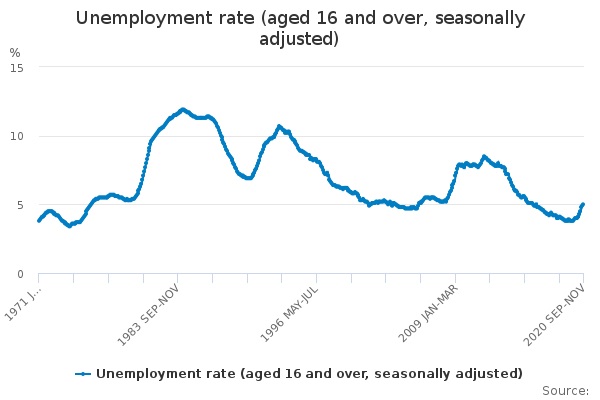UK Unemployment Continues to Rise With Young People Hard Hit
Tuesday 26 January, 2021 Written by Simon Collyer
UNEMPLOYMENT - The number of people out of work in the UK has continued to rise, with those aged 25 to 34 facing the biggest risk of losing their jobs according to the BBC.
In the three months to November, people in that age group had a redundancy rate of 16.2 per 1,000, a fivefold increase on the same period a year earlier.
Since February 2020, the number of payroll employees has fallen by 828,000; however, the larger falls were seen at the start of the coronavirus (COVID-19) pandemic.
Data from the ONS Labour Force Survey (LFS) show a large increase in the unemployment rate while the employment rate continues to fall. The number of redundancies reached a record high in September to November 2020, although the weekly data show it has dropped from the peak in September.
Although decreasing over the year, total hours worked increased from the low levels in the previous quarter, even with the September to November period covering a time when a number of coronavirus lockdown measures were reintroduced. The number of people temporarily away from work has fallen since its peak in April and May 2020, although it has risen slightly in November. The number of people away from work because of the pandemic and receiving no pay has also fallen since the start of the pandemic but risen slightly over the last month.
The vacancies recovery has slowed in October to December 2020 and these are still below the levels seen before the impact of the coronavirus pandemic.

Image: Courtesy of the ONS show that job vacacies has plunged.
Annual growth in average employee pay continued to strengthen, but this growth is increasingly being driven by compositional effects of a fall in the number and proportion of lower-paid employee jobs. Current average pay growth rates are being impacted upwards by a fall in the number and proportion of lower-paid jobs compared with before the coronavirus pandemic; it is estimated that underlying wage growth – if the effect of this change in profile of jobs is removed – is likely to be under 2%.
The UK employment rate, in the three months to November 2020, was estimated at 75.2%, 1.1 percentage points lower than a year earlier and 0.4 percentage points lower than the previous quarter.
The UK unemployment rate, in the three months to November 2020, was estimated at 5.0%, 1.2 percentage points higher than a year earlier and 0.6 percentage points higher than the previous quarter.
In the three months to November 2020, the redundancy rate reached a record high of 14.2 per thousand.
Early estimates for December 2020 indicate that the number of payrolled employees fell by 2.7% compared with December 2019, which is a fall of 793,000 employees; since February 2020, 828,000 fewer people were in payrolled employment.
The Claimant Count increased slightly in December 2020, to 2.6 million; this includes both those working with low income or hours and those who are not working.
There were an estimated 578,000 vacancies in the UK in October to December 2020; this is 224,000 fewer than a year ago and 81,000 more than the previous quarter.
Growth in average total pay (including bonuses) among employees for the three months September to November 2020 increased to 3.6%, and growth in regular pay (excluding bonuses) also increased to 3.6%.

Image: Courtesy of the ONS shows that unemploment is rising due to the pandemic.
ABC Comment, have your say below,

1 comment
Leave a comment
Make sure you enter all the required information, indicated by an asterisk (*). HTML code is not allowed.
Join
FREE
Here










